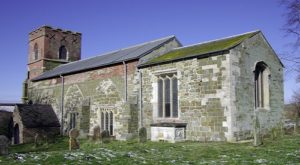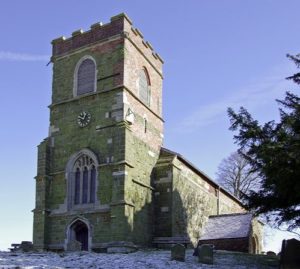Burwell is a small village on the A16 south of Louth. It used to be a busy medieval market town. The 17thC buttercross near the church is now the village hall. It was the site of Burwell Priory which was a Benedictine Monastery dissolved in 1452.
St Michael’s is a delightful stone building set on a rise of the Lincolnshire Wolds on the edge of the village, reached up a green lane lined with trees and daffodils and has superb views across the rolling Wolds. It is set in an old graveyard with snowdrops and birdsong drowning out the traffic noise from the A16.
First sight of the church is the massive green sandstone tower with heavy buttresses at the west end. It has a sundial on the south west corner and a huge perpendicular window above the west door. The tower is 16thC but the brick top was added in the 18thC,
The nave is early 12thC and has the remains of four filled in arches on the south wall. Each contain a large square perpendicular window, added later. The chancel is lower than the nave and added in the 14thC. By the south wall is a rather nice stone box tombstone with a carving of a skull on the end.
Entry is through the later south porch and there are a couple of steps up into the church.
Conservation work was carried out in 2010 and the inside whitewashed and gleams. There is a lovely Norman chancel arch with pillars with carved capitals of stags or scrolls and chevron carving round the archway. Unfortunately the whitewash does mask detail.
At the top left hand corner is the remains of a small medieval wall painting of a crowned head delicately outlined in black. It is thought this might be the Virgin Mary as there is a letter M beside the coronet.
At the back of the church is a 15thC carved stone font with old gravestones on the floor. The rest of the floor is hexagonal red quarry tiles.
The roof has wooden cross beams with decorative open carvings. Originally there would have been carved figures at the base. These are now gone although three angels survive on the roof of the tower. The tower is separated from the nave by a elegant pointed arch and a carved wooden screen with decorative gilt flowers and badges.
On the north wall opposite the doorway is a diamond hatchment.
There are old wooden pews raised on a wood plinth above the floor, presumably as an attempt to keep feet warmer. There is a beautifully carved Jacobean pulpit with arches and square designs. There is a similar pattern on the priest’s chair in the chancel.
Three steps lead up into the chancel and another two to the altar rail. The chancel floor has red and yellow floor tiles and the wooden cross beams of the roof are much plainer.
The altar rail is 19thC and on the left hand side still has carvings of vine leaves and grapes.
There is a beautifully carved wooden altar with flowers and shields and a small crucifix on the top. To the left is a carved base which would have supported a statue. Above is a stained glass window with St Michael in the centre with the scales of justice on the left and a sword and crown on the right. The rest of the windows in the church are plain glass.
Running round the wall of the chancel is a narrow wooden dado rail with carved flower heads. On the walls are slate and marble memorials to members of local gentry.
This is a delightful parish church and well worth seeking out. For those with mobility problems, the lane to the church is quite steep. Also being built on a slope, there are steps inside the church.
There is a little parking in a small lay by by the green lane to the church.
While he was taking photos outside, a DC3 with invasion stripes painted on its wings flew over. That made husband’s day…
No longer in use, the church is looked after by the Churches Conservation Trust and is always open.









